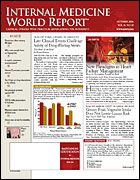Publication
Article
Internal Medicine World Report
Mounting Evidence Show Circumcision Can Protect Against HIV
Author(s):
From the International AIDS Conference
TORONTO?It has long been debated whether male circumcision could have a role in halting the spread of HIV infection. New evidence has come close to settling this debate, showing that male circumcision can lower the rate of HIV infection by as much as 75%.
Widespread use of this practice in sub-Saharan Africa could prevent millions of new HIV infections and hundreds of thousands of deaths over the next 10 years, according to research presented at the XVI International AIDS Conference. These data are from 2 of the more than 3 dozen studies presented at the meeting on the impact of circumcision on the spread of HIV infection.
Robert Bailey, PhD, MPH, professor of epidemiology, School of Public Health, University of Illinois at Chicago, and the principal investigator of an ongoing trial in Kisumu, Kenya, discussed his study that is comparing circumcised men with uncircumcised men. The World Health Organization and the United Nations Program on HIV/AIDS are awaiting the completion of a few ongoing trials to update their policy about male circumcision.
"These organizations are waiting for the additional results from our trial and from another randomized trial being done in Raki, Uganda, before they are prepared to promote male circumcision as an additional HIV transmission/prevention strategy," said Dr Bailey.
The buzz about male circumcision has been created by the more than 40 observational studies that have shown that it affords men strong protection against acquiring HIV. The likely explanation begins with the many HIV target cells in the foreskin.?In addition, since the inner foreskin lacks a squamous epithelial layer, the target cells are exposed to the virus. ?
The most important of these studies is a large randomized controlled trial involving South African men that was published online last fall (PLoS Med.?2005;2:e298). Intent-to-treat analysis showed that male circumcision yielded a 61% protective effect against HIV infection.
This risk reduction was the basis for a model used in a second study (PLoS Med.? 2006; 3:e262) showing that promoting male circumcision as a public health intervention in sub-Saharan Africa could prevent 2 million new HIV infections and 300,000 deaths over the next 10 years. These data were also presented at the meeting.
Other data presented included interim findings from another ongoing, 3-year study of HIV incidence in a cohort of 1719 circumcised (n = 1321) and uncircumcised (n = 398) men living on a tea plantation in Kericho, Kenya.
At baseline, there was a significant difference in HIV prevalence between the 2 groups, with 24.9% of the uncircumcised men being HIV positive compared with only 7.3% of the circumcised men.
Analysis showed that the odds ratio for HIV infection in circumcised men was 0.24 compared with uncircumcised men. This significant difference persisted at 1.5 years of follow-up (odds ratio, 0.28; P?<.001).
In their ongoing trial, Dr Bailey and colleagues randomized 2784 men to be circumcised (n = 1391) or to remain uncircumcised (n = 1393).
Despite concerted efforts by the study team to limit risky behaviors by participants, 71 seroconversions had occurred in the 2 groups as of July 17, 2006. Barring an early end to the study, the final results are expected by the end of 2007.





